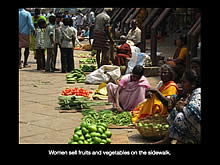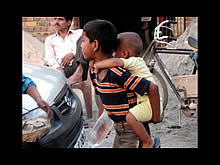
BANGALORE, INDIA—“How do you make the camera snap?” asked 14-year-old Prakash, a student at Government High School-Cotton Pet in Bangalore. “I have never known a camera before,” he told us, with his teacher translating into English from Kannada, the city’s most common language.
Over the next several days, Prakash and his classmates took close to 2,000 photographs with the digital cameras we gave them, capturing daily life in their neighborhood and in the city’s largest open market and park. Just minutes after learning how to “snap,” the students were producing photos that took one’s breath away. An 87-year-old great-grandmother doing her family’s laundry in the small courtyard of their school. Pushcart workers straining in front of the Krishna Rajendra market. A vegetable seller taking an afternoon nap. A finely dressed family picnicking in Cubbon Park.
These new young photographers in Bangalore were part of a larger documentary photo project, which What Kids Can Do (WKCD) carried out in 2006 and 2007 with student teams in Noida and New Delhi, as part of the international initiative, Adobe Youth Voices.
Students at Noida Public Senior Secondary School spent the year gathering photographs and interviews that showed the contrasts globalization now produces at every turn in India: between old and new, Eastern and Western, rich and poor, traditional and progressive, multinational and local. Animals from a traveling circus grazing next to a shiny mega-mall. A corporate lawyer whose career has blossomed with the globalized economy. A freight-forwarder who feels engulfed by the demands of a 24/7 world.
In New Delhi, youth leaders in the Bal Panchayat program of Plan International-India took cameras to the slum neighborhoods they know intimately, putting a human face to their passionate campaign for children’s rights in India. A mother bathing a contented infant. A girl fetching water from a pump, against a backdrop of rags. An eleven-year-old boy carrying a bag as big as he is. Two young friends with joyous smiles.
The result is a vibrant collection of audio slideshows, plus a book, India in a Time of Globalization: A Photo Essay by Indian Youth.
 |
A Day in the Life of Bangalore |
 |
Child Labor and Rights |
 |
Globalization |
 |
Come Learn Some Hindi with Us |
 |
India at a Time of Globalization: A Photo Essay by Indian Youth (Next Generation Press, 2008)) |
Bookmark with: ![]() Digg
Digg
![]() StumbleUpon
StumbleUpon
![]() Delicious
Delicious
![]() Reddit What are these?
Reddit What are these?

